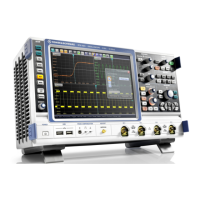Protocol Analysis
R&S
®
RTO
250User Manual 1316.0827.02 ─ 06
10 Protocol Analysis
With the R&S RTO and some additional options, you can analyze the following serial
protocols:
●
SPI (Serial Peripheral Interface) - decoding requires option R&S RTO-K1
●
I²C (Inter-Integrated circuit bus) - decoding requires option R&S RTO-K1
●
UART/RS232 (EIA-232 serial interface) - decoding requires option R&S RTO-K2
●
CAN - decoding and triggering requires option R&S RTO-K3
●
LIN - decoding and triggering requires option R&S RTO-K3
●
FlexRay - decoding and triggering requires option R&S RTO-K4
Triggering on SPI, I²C and UART is available with the main R&S RTO without any options.
● Basics of Protocol Analysis...................................................................................250
● I²C ........................................................................................................................256
● SPI Bus.................................................................................................................269
● UART / RS232......................................................................................................278
●
CAN (Option R&S RTO-K3)..................................................................................286
●
LIN (Option R&S RTO-K3)....................................................................................296
●
FlexRay (Option R&S RTO-K4)............................................................................307
10.1 Basics of Protocol Analysis
Before you can analyze a serial signal, the bus has to be configured according to the
protocol and specifics of the signal. The configuration contains:
●
Assignment of the data and clock lines to the input channels
●
Logical thresholds
●
Protocol-specific settings
Serial data can be analyzed in two ways:
●
Triggering: You can trigger on various events that are typical for the selected protocol
type, for example, on start and stop of messages, on specific addresses, or on speci-
fied data patterns in the message.
Triggering on a trigger event sequence is not supported, and holdoff settings are not
available.
For all serial protocols except for SPI, I²C and UART, triggering requires an option.
●
Protocol decoding: The digitized signal data is displayed on the screen together with
the decoded content of the messages in readable form, and the decoding results are
listed in a table.
For all serial protocols, decoding requires an option.
Basics of Protocol Analysis

